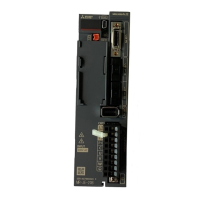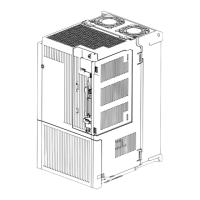2. SIGNALS AND WIRING
2 - 15
Device Symbol
Connector
pin No.
Function and application
I/O
division
Control
mode
CP CL
Point table No./
program No.
selection 1
DI0 CN1-19 Point table method
Select point tables and home position return mode with DI0 to DI4.
DI-1
Point table No./
program No.
selection 2
DI1 CN1-41 Device (Note 1)
Selection contents
DI4
(Note 2)
DI3 DI2 DI1 DI0
Point table No./
program No.
selection 3
DI2 CN1-10 0 0 0 0 0 Home position
return mode
0 0 0 0 1 Point table No. 1
Point table No./
program No.
selection 4
DI3 CN1-35 0 0 0 1 0 Point table No. 2
0 0 0 1 1 Point table No. 3
Point table No. 5 DI4
1 1 1 1 0 Point table No. 30
1 1 1 1 1 Point table No. 31
Note 1.
0: Off
1: On
2. DI4 is available only with the communication function. This
device cannot be assigned as an input signal.
Program method
Select program Nos. with DI0 to DI3.
Device (Note)
Selection contents
DI4 DI3 DI2 DI1 DI0
0 0 0 0 0 Program No. 1
0 0 0 0 1 Program No. 2
0 0 0 1 0 Program No. 3
0 0 0 1 1 Program No. 4
1 1 1 1 0 Program No. 15
1 1 1 1 1 Program No. 16
Note.
0: Off
1: On
Mark detection MSD The current position latch function by sensor input can be used. For the
current position latch function, refer to section 6.2.1. For the current
position latch function, refer to section 6.2.2.
DI-1
Proportional
control
PC Turn PC on to switch the speed amplifier from the proportional integral
type to the proportional type.
If the servo motor at a stop is rotated even one pulse due to any external
factor, it generates torque to compensate for a position shift. When the
servo motor shaft is to be locked mechanically after positioning
completion (stop), switching on the PC (Proportion control) upon
positioning completion will suppress the unnecessary torque generated to
compensate for a position shift.
When the shaft is to be locked for a long time, switch on the PC
(Proportion control) and TL (External torque limit selection) at the same
time to make the torque less than the rated by TLA (Analog torque limit).
DI-1

